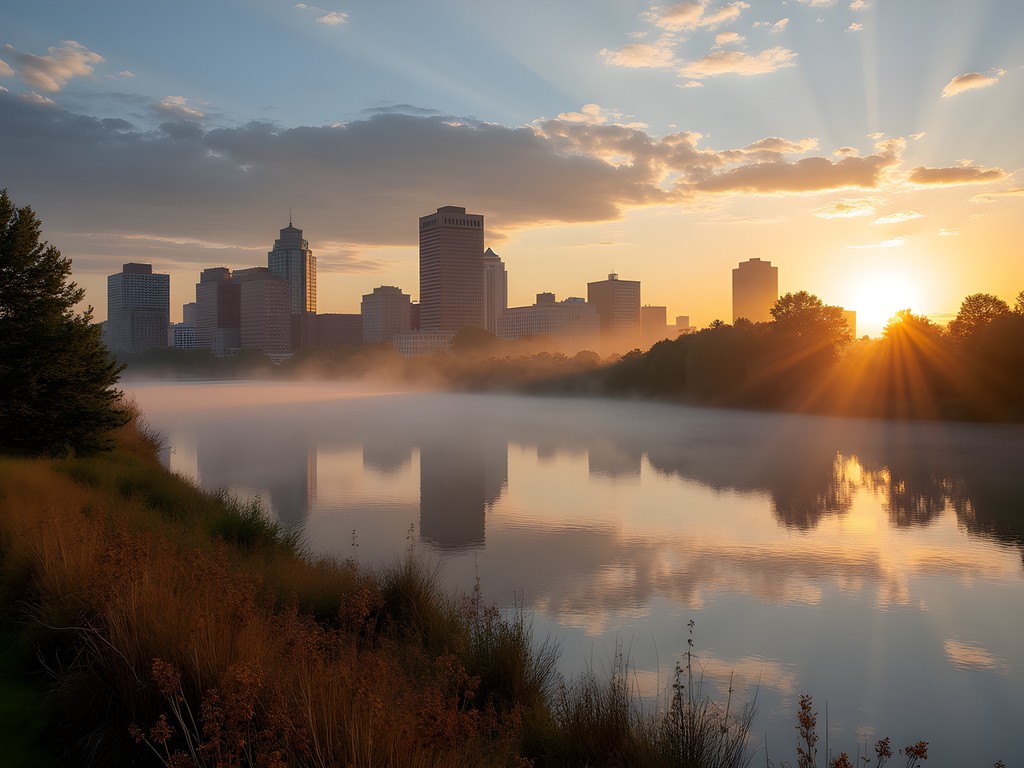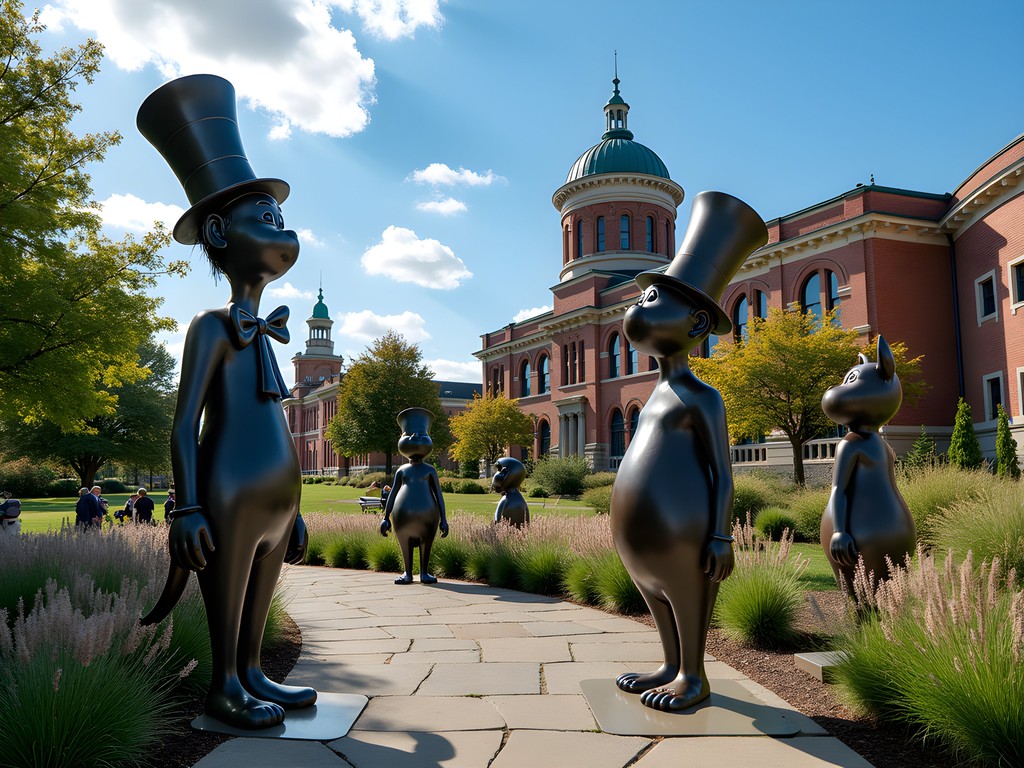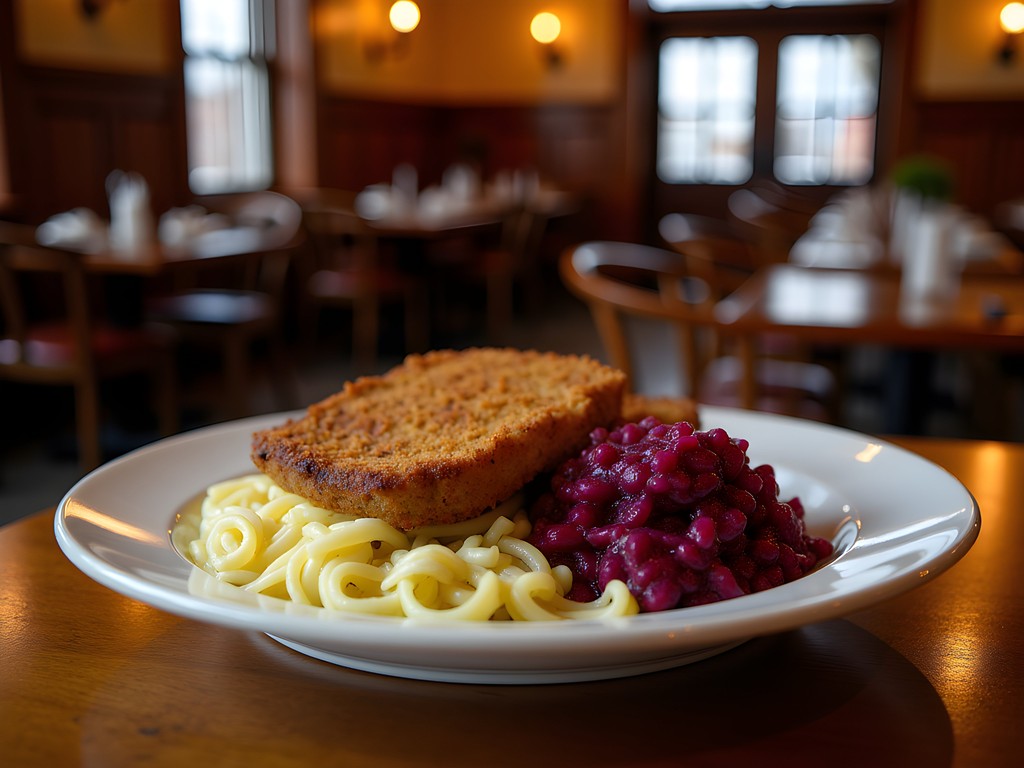Disclosure: This article contains affiliate links. We may earn a commission from purchases at no extra cost to you, which helps our travel content.
Standing at the confluence of four rivers with my worn Merrell Moab hiking shoes firmly planted on historic ground, I couldn't help but feel the palpable energy of Springfield's transformation. This Massachusetts city—once the industrial heartbeat of New England—has reinvented itself while honoring its manufacturing legacy. As someone who studies ecosystems professionally, I find urban evolution equally fascinating: the adaptive reuse of brick factories into vibrant cultural spaces, industrial canals reimagined as recreational corridors, and the resilient community breathing new life into historic neighborhoods.
The Ecological Succession of Springfield's Architecture
In ecology, we study how environments transform after disruption—a process called succession. Springfield's architectural landscape demonstrates this phenomenon brilliantly in the built environment. The city's red-brick industrial complexes once powered America's manufacturing revolution, producing everything from rifles to railroad cars.
Now, these massive structures have adapted to new purposes. The Springfield Armory National Historic Site stands as a testament to this evolution. Once America's first federal armory (1794-1968), it now houses a museum where industrial history meets educational opportunity. Walking through its grounds, I traced my fingers along brick walls that witnessed centuries of American innovation.
Nearby, the former Indian Motorcycle factory has transformed into loft apartments. This adaptive reuse preserves architectural heritage while meeting contemporary needs—an urban conservation success story that would make any scientist proud.

💡 Pro Tips
- Visit the Springfield Armory early on weekdays to avoid crowds and get personalized attention from knowledgeable rangers
- Look for the 'ghost signs'—faded advertisements still visible on brick buildings throughout downtown
- Bring a lightweight tripod for low-light photography inside industrial spaces—many still have original fixtures worth capturing
Urban Rivers: Springfield's Blue Corridor Revival
As a conservation scientist, I'm naturally drawn to waterways—they're the lifeblood of any ecosystem, including urban ones. Springfield sits at the convergence of the Connecticut, Chicopee, Mill, and Westfield rivers, a geographical advantage that powered its industrial rise.
Today, these waterways are being reclaimed through impressive conservation efforts. The Connecticut River Walk and Bikeway offers a 3.7-mile paved path where I spent a refreshing morning observing both river ecology and city skyline. Armed with my trusty waterproof notebook, I documented native plant species reclaiming riverbanks once dominated by industry.
For the budget-conscious explorer, this riverside corridor offers free recreation with million-dollar views. I recommend packing a simple lunch and finding one of the many riverside benches—my favorite sits just north of the Memorial Bridge, where you can watch boats navigate while peregrine falcons hunt from skyscraper perches above.

💡 Pro Tips
- Visit at dawn to spot wildlife returning to the urban river ecosystem—I've seen herons, falcons, and even river otters
- Download the free Connecticut River paddling trail maps before visiting to identify access points
- Bring polarized sunglasses to reduce glare and better observe underwater river features
The Dr. Seuss National Memorial: Whimsy Amid Industry
Few visitors realize that Springfield birthed one of America's most beloved storytellers: Theodor Geisel, better known as Dr. Seuss. The Dr. Seuss National Memorial Sculpture Garden in the Springfield Museums Quadrangle creates an enchanting juxtaposition against the city's industrial backdrop.
As someone who values both scientific accuracy and imaginative thinking, I find this garden particularly inspiring. Bronze sculptures of familiar characters emerge from the landscape—the Lorax (my personal favorite, with his environmental message) stands proudly alongside Horton, the Cat in the Hat, and Geisel himself.
Visiting on a budget? The outdoor sculpture garden is free to explore, though I recommend investing the $25 admission to access all five Springfield Museums. I spent hours sketching the sculptures in my travel sketchbook, finding unexpected inspiration in how Geisel transformed his industrial hometown into fantastical landscapes through imagination.
Budget tip: Visit on the first Friday evening of each month when museum admission is free from 5-8pm!

💡 Pro Tips
- Visit the Amazing World of Dr. Seuss Museum first thing in the morning before school groups arrive
- Look for environmental messages in Seuss's work—The Lorax offers powerful conservation lessons relevant to Springfield's industrial history
- Springfield Museums offer free admission on the first Friday evening of each month from 5-8pm
MGM Springfield: Industrial Artifacts in Modern Entertainment
Even as a conservation scientist who typically gravitates toward natural settings, I found myself fascinated by MGM Springfield's approach to urban redevelopment. This entertainment complex represents a $960 million investment in downtown revitalization, yet what impressed me most was its commitment to preserving historical elements.
Rather than erasing industrial history, MGM Springfield incorporated it. The complex salvaged and repurposed elements from historic buildings, including the façade of the 19th-century State Armory. Walking through the property feels like exploring a museum of Springfield's industrial past—chandeliers crafted from antique factory components, vintage industrial gauges as decorative elements, and historical photographs throughout.
For the budget-conscious explorer, you can experience this architectural preservation without spending on gaming. I enjoyed a reasonably priced coffee at Starbucks inside while documenting the integration of historical artifacts. My clip-on smartphone lenses helped capture detailed images of architectural elements that might otherwise go unnoticed.
This approach to development—honoring history rather than erasing it—offers valuable lessons for sustainable urban transformation worldwide.

💡 Pro Tips
- Take the free self-guided architectural tour available through the MGM Springfield app to identify historical elements
- Visit the restored 1895 State Armory façade at night when dramatically lit
- Look for the Indian Motorcycle exhibition showcasing Springfield's manufacturing heritage
Springfield's Urban Food Ecosystem on a Budget
Every ecosystem needs efficient energy transfer—in urban exploration terms, that means finding quality, affordable food! Springfield's culinary landscape reflects its diverse cultural heritage while offering excellent options for budget travelers.
My scientific approach to travel includes mapping affordable culinary hotspots. The Student Prince and Fort Restaurant, operating since 1935, offers German cuisine that reconnected me with my Hamburg roots. Their lunch specials (under $15) provide excellent value, with the jagerschnitzel transporting me straight back to childhood family meals.
For breakfast, I discovered Nosh Restaurant & Café in Longmeadow (just outside downtown), where locally-sourced ingredients create sustainable and delicious morning fuel. Their avocado toast with Springfield-made hot sauce powered my urban explorations for hours.
Street food also thrives here—don't miss the food trucks that gather at Riverfront Park on summer weekends. I always carry my reusable utensil set to minimize waste while enjoying these affordable culinary adventures.
My conservation background appreciates establishments focusing on local sourcing. The Farm Table at Kringle Candle Company (about 30 minutes north) exemplifies farm-to-table dining with ingredients from their own fields—worth the short drive for sustainability-minded explorers.

💡 Pro Tips
- Visit The Student Prince during weekday lunch hours for the best German food value
- Check Springfield Museums website for their occasional food truck festivals featuring local vendors
- Many downtown restaurants offer happy hour specials from 4-6pm on weekdays with significantly discounted small plates
Final Thoughts
As my weekend in Springfield drew to a close, I found myself reflecting on the parallels between natural and urban ecosystems. Both demonstrate remarkable resilience, adapting to changing conditions while maintaining core identity. Springfield doesn't hide its industrial past—it celebrates and transforms it, creating something entirely new yet authentically rooted in history.
For the urban explorer seeking transformation stories, Springfield offers a masterclass in adaptive reuse without requiring a massive budget. The city reminds us that conservation isn't just about preserving pristine wilderness—it's about thoughtfully evolving our built environments too.
As I packed my packing cubes and prepared for departure, I realized Springfield had shifted my perspective on urban exploration. Sometimes the most profound ecological lessons come not from coral reefs or rainforests, but from cities reinventing themselves one brick building at a time. Whether you're drawn to industrial heritage, riverside ecology, or cultural revival, Springfield's transformation story deserves a chapter in your travel journey.
✨ Key Takeaways
- Springfield demonstrates urban resilience through adaptive reuse of industrial architecture
- The city offers excellent budget-friendly urban exploration opportunities with free or low-cost attractions
- Conservation principles apply to built environments just as they do to natural ones
- Cultural preservation and innovation can coexist, creating unique urban experiences
📋 Practical Information
Best Time to Visit
year-round, though May-October offers pleasant weather for outdoor exploration
Budget Estimate
$200-350 for a weekend (accommodation, food, and attractions)
Recommended Duration
2-3 days
Difficulty Level
Intermediate - Requires Some Walking Between Sites
















Comments
wavemate
Just added Springfield to my fall road trip! The architecture looks amazing.
escapelife
Those river photos are stunning! Never seen Springfield look so good.
Claire Hawkins
Elena, your post brought back memories of our family trip to Springfield last year! My kids were absolutely enchanted by the Dr. Seuss National Memorial - they recognized all the characters and spent hours running between sculptures. What I appreciated most was how family-friendly the revitalized areas are. The riverside paths were perfect for our morning walks, and even MGM Springfield had those unexpected kid-friendly spaces (though we mostly stuck to the non-gaming areas). The Basketball Hall of Fame was another hit with my 10-year-old. Springfield really does balance its industrial heritage with modern family attractions beautifully. Your ecological succession metaphor is perfect - these cities aren't dying, they're evolving!
greenrider
This looks amazing! I'm planning a New England road trip next month and thinking of adding Springfield. How many days would you recommend staying there?
Elena Wells
@greenrider I'd recommend 2 full days to really explore without rushing. One day for the downtown/museums and another for the riverfront areas and MGM if that interests you!
greenrider
Thanks Elena! Adding it to my itinerary now. Can't wait to see the Dr. Seuss sculptures!
Fatima Sims
Elena, this resonates with me so much! I visited Springfield last month as part of my 'Overlooked American Cities' series, and the ecological metaphor you used is spot on. The way the Connecticut River corridor has been revitalized reminds me of similar projects I saw in Pittsburgh. I spent hours at the Dr. Seuss Memorial with my camera - something magical about those sculptures against the industrial backdrop. The contrast tells such a story! I walked everywhere in my hiking shoes since the riverfront paths connect everything so nicely. Your post captures exactly what makes these transitional cities so fascinating - they're living museums of American economic evolution.
wavemate
Fatima, love your 'Overlooked Cities' series! Have you done Lowell, MA yet? Similar industrial-to-arts transformation.
Fatima Sims
@wavemate Lowell is actually next on my list! Planning to visit in November to explore the textile mill history.
nomadchamp
Great post! Never considered Springfield as a destination before.
oceannomad
Elena, your post perfectly captures Springfield's vibe! I was there last summer and was blown away by how they've integrated the industrial past into new spaces. The MGM Springfield was such a surprise - those factory artifacts mixed with modern entertainment spaces felt so authentic compared to typical casino designs. Did you check out the Springfield Armory? That was another highlight for me - crazy to think how much American history happened right there!
escapelife
The Armory is so underrated! Those vintage firearms collections are incredible.
blueguide
Those shots of the old factory buildings with modern additions are STUNNING! Love how you captured the contrast between old brick and new glass. The Dr. Seuss sculptures look magical too - my kids would go crazy for those! Do you think winter would be too cold to enjoy the outdoor spaces? Thinking of a December visit when we're in the area for family stuff.
Elena Wells
Thank you! December can definitely be chilly, but the Dr. Seuss garden is still charming in winter (sometimes with snow on the sculptures!). MGM Springfield and the museums make great indoor options too. Just layer up for the outdoor portions!
cooldiver
How's the public transportation situation there? Worth renting a car or can you get around easily? Planning a weekend trip and trying to decide. Those Merrell hiking shoes you mentioned sound perfect for urban exploring - my boots are pretty worn out after my last few trips.
Elena Wells
The downtown core is pretty walkable, but I'd recommend a car if you want to explore beyond that. The bus system works for basic routes, but schedules can be limited on weekends. And yes, my Merrell Moabs were perfect - comfortable enough for all-day urban exploration but rugged enough for the riverside trails!
cooldiver
Thanks for the tip! Will definitely rent a car then. Looking forward to checking out those riverside trails.
Douglas Bradley
Elena, your analysis of Springfield's urban ecosystem parallels is fascinating. I've been studying post-industrial revitalization across the Northeast, and Springfield represents an interesting case study in how cities leverage their manufacturing heritage rather than erasing it. The four-river confluence creates a unique geographic advantage that few cities possess. Did you notice how the architectural styles shift as you move from the riverfront toward downtown? There's an almost chronological storytelling in the built environment that traces the city's evolution. I'm curious if you explored any of the adaptive reuse projects in the old Armory district?
Elena Wells
Thanks Douglas! I did spend some time in the Armory district - those converted factory spaces with their massive windows and exposed brick are incredible. The arts community there is really leveraging that industrial aesthetic. Would love to exchange notes on other Northeast revival cities sometime!
Venture X
Premium card with 2X miles, $300 travel credit, Priority Pass